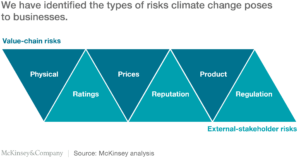SHARING BEAUTY WITH ALL – L’OREAL IN FIGHT AGAINST CLIMATE CHANGE

L’Oréal recognized as authority in climate change mitigation for 4th year in a row!
While zeitgeist usually associates climate change with energy companies and heavy manufacturers, the substantial issue is not off the playing field for other industries. As the world’s leading beauty company for 105 years, L’Oréal has been recognized as an authority in climate change mitigation for the fourth year in a row. [1] Its breakthrough Sharing Beauty With All sustainability commitments and achievements constitute an opportunity to build its reputation and lay the foundations for future growth.
***
L’Oréal has aimed to accelerate its transition to a low carbon business since 2005. [2] The group is taking on its fate by managing its footprint, controlling the transparency of its policies and ultimately enhancing its positioning. Innovation, production, customers and suppliers are four key areas to protect from the threats of physical and regulatory risks related to climate change.
Everything starts with innovation. In order to preempt constraining regulatory decisions and subsequent public bad will, L’Oréal is focusing on reducing the environmental footprint of its formulas, respecting biodiversity, optimizing packaging and removing itself from deforestation. By 2020, all new formulas will be made of renewable raw materials, increasingly biodegradable and feature a lower water footprint. As many as “40,000 formulas in all 19 types of product made by the Group were analyzed by [L’Oréal] experts in 2014 and 2015.” [2] The group is also responsibly sourcing soya and palm oils and wood-fiber based products in order to separate from deforestation. This helps control risks linked to variability in raw material pricing. Lastly, products will be sourced from entirely sustainable supply chains.
Production and distribution are equally core to the business. L’Oréal is committed to reducing C02 emissions in absolute terms, water consumption and waste per unit of finished good. The goal is to lower the environmental footprint of L’Oréal’s plants and distribution centers by 60% (2005 baseline) by 2020. [2]
And yet, the most important stakeholders are customers. In an effort to raise awareness and empower them to make informed lifestyle decisions, the group focuses on assessing its products’ footprint and sharing it transparently. L’Oréal’s brands have implemented initiatives or awareness campaigns. These include Biotherm’s Water Lovers, which preserves the planet’s water resources and aquatic biodiversity with Mission Blue [3], and Giorgio Armani’s Acqua for Life, which provides access to clean water with Green Cross International. [4]
Lastly, L’Oréal is keen on controlling its supply chain by engaging with suppliers. By 2020, the group will select suppliers based on their environmental commitment and provide them with tools to collaborate on improving their performance. [2]
 Results are promising. Between 2005 and 2015, carbon emissions had reduced by 56 percent, despite a 26 percent increase of production in the same timeframe. [1] However, L’Oréal values control over the political scene as well. Ahead of the COOP 21 Paris Climate Conference back in 2015, “the heads of 59 international companies, including Airbus, the manufacturer, L’Oréal, the cosmetics company, and media group Publicis, signed a statement calling for carbon pricing”. [5] L’Oréal publicly voiced the necessity to instigate global carbon pricing if emissions were to be reduced in a meaningful way. The group advocates for a market-based solution instead of a top-down interventionist mandate framework.
Results are promising. Between 2005 and 2015, carbon emissions had reduced by 56 percent, despite a 26 percent increase of production in the same timeframe. [1] However, L’Oréal values control over the political scene as well. Ahead of the COOP 21 Paris Climate Conference back in 2015, “the heads of 59 international companies, including Airbus, the manufacturer, L’Oréal, the cosmetics company, and media group Publicis, signed a statement calling for carbon pricing”. [5] L’Oréal publicly voiced the necessity to instigate global carbon pricing if emissions were to be reduced in a meaningful way. The group advocates for a market-based solution instead of a top-down interventionist mandate framework.
Risks related to climate change are plentiful and can have substantial impact on business prospects. L’Oréal is currently focusing on its value-chain and pure external stakeholder risks such as product, prices, reputation and regulation. But more can be done… [6]
The physical risks linked to the frequency and severity of extreme weather events and their damaging effects can be addressed. Forecasting a range of possible scenarios and building in geographic variability will help. Further control on pricing can be initiated to limit price volatility and input uncertainties. Also, as environmentally conscious habits have been passed on to consumers, price-sensitivity is less of an issue.
***
Although beauty and the broader retail industry are responsible for little emissions overall, they view the fight against climate change as an opportunity to create competitive advantages. As L’Oréal has well identified since 2001, preempting changes in dynamics on such a complex, pressing and persistent topic is crucial. Indeed, the breadth and magnitude of the likely physical and regulatory impacts could change the entire context in which its business operates, from operations and industry dynamics to supply chains and customers. The wide range of risks presents new opportunities to differentiate brands and products, gain credit with customers and suppliers, reduce costs, and pave the way for future growth.
[1] L’Oreal 2015 annual report
[2] Sharingbeautywithall.com
[3] Missionblue.com
[4] Greencross international.com
[5] Financial Times, Oligarch calls for worldwide carbon tax “or die”
[6] McKinsey study, How Companies Can Adapt To Climate Change
(751 words)






That is interesting but I would question the motivation of L’Oreal.
It seems L’Oreal is more focused on sustainability of its formula rather than end to end sustainable solutions.
Most of their efforts seem to have been around sourcing stability and price variation rather than reducing PVC packaging [1], reviewing channels logistics.
[1] http://www.cosmeticsdesign-europe.com/Packaging-Design/L-Oreal-reiterates-importance-of-sustainability-AND-safety-of-plastic-packaging
Similar comment to Aratak above; I think L’Oreal’s next steps could be to make amendments to its packaging, perhaps focusing on recycled materials or to push consumers to recycle their cosmetic packaging/containers by disposing it at the stores. I think an “all-natural, sustainable” series would be well-received from environmental-friendly consumers, and it could be paired easily with the already implemented initiatives.
Thanks for the very insightful post! It’s great to see a global leader like L’Oreal making meaningful efforts to become more sustainable. Hopefully, this serves as an example of the other major beauty and cosmetics companies around the world. A sustainability leader like L’Oreal should be looking across the entire value chain – from the sourcing of raw materials through customer use and disposal – for opportunities to reduce its footprint. As the commenters above have mentioned, there does seem to be opportunity for L’Oreal to focus on it’s packaging to reduce waste. For example, L’Oreal could consider using recycled or biodegradable plastics and should ensure that its packaging is designed to for optimized shipping. With that said, L’Oreal is definitely doing a commendable job and will likely be a sustainability leader well into the future given the commitment it made by signing Obama’s American Business Act on Climate pledge.